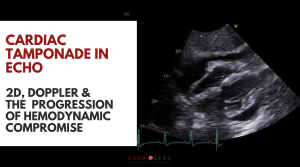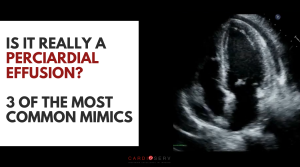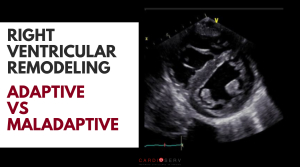Last Updated on January 30, 2024 by Hannes van der Merwe
ACCREDITATION HACK – PART ONE
We want to make sure you start the year off right in regards to meeting the new Intersocietal Accreditation Commission (IAC) Quality Improvement requirements and provide you with time saving tricks and techniques to ensure compliance. Whether your accreditation is in echocardiography, vascular, nuclear, MRI or CT we know how easy it is to fall behind on your quarterly QI requirements. We want to help you with our blog series on Accreditation Hacks. Don’t be fooled by the name, we want to teach you time hacks but never quality hacks! We believe in the process of accreditation to improve diagnostic healthcare and always focus on improving quality while saving time. This week in part one we will present a clear understanding of the new Quality Improvement changes across each modality.
Last year the Intersocietal Accreditation Commission (IAC) announced that they were standardizing their Quality Improvement Programs across all modalities. This change was to address the variations between divisions within IAC and to ease the burden of maintaining accreditation. The standardization had little change on some modalities like echocardiography and massive changes for other modalities like vascular. IAC standardized the QI program by establishing four key measures for all modalities to follow while still allowing each modality the option to add a division-specific measure, which we like to call the wild card.
Remember, self-assessment through QI is a way for facilities to learn how they practice and determine areas where improvement can be made. There are many different ways to incorporate the IAC QI requirements. We will review our best practices in regards to completing each of these measures in detail throughout this blog series and provide you with accreditation hacks to meet each standard. First let’s review the new standardized QI program and how it affects each specific modality.
The four across-the-board QI measures required for all imaging modalities are:
- Test Appropriateness
- Technical Quality
- Interpretive Quality
- Report Completeness
The effective dates of these changes are mostly February 2016 with MRI rolling out a little later in March. Nuclear has yet to release the new requirements so a much later effective date is expected.
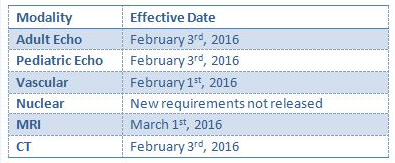
TEST APPROPRIATENESS
This measure is known to most as its previous name of Appropriate Use Criteria (AUC). The measure requires all modalities to assess the appropriateness of testing indications with the exception of pediatric echocardiography, as there is currently no AUC white paper with published industry standards. Once the pediatric echo AUC paper is published this measure will be added. In addition to renaming this measure from AUC to Test Appropriateness there have been changes to the terminology of the appropriateness categories.

Although Test Appropriateness is mandated across all imaging modalities the number of required studies to include in this mandated measure changes from modality to modality. While some divisions provide a specific number of studies to be reviewed other divisions did not specify an exact number. Vascular never required any kind of Test Appropriate tracking in the past. This is a brand new measure for the Vascular Division.
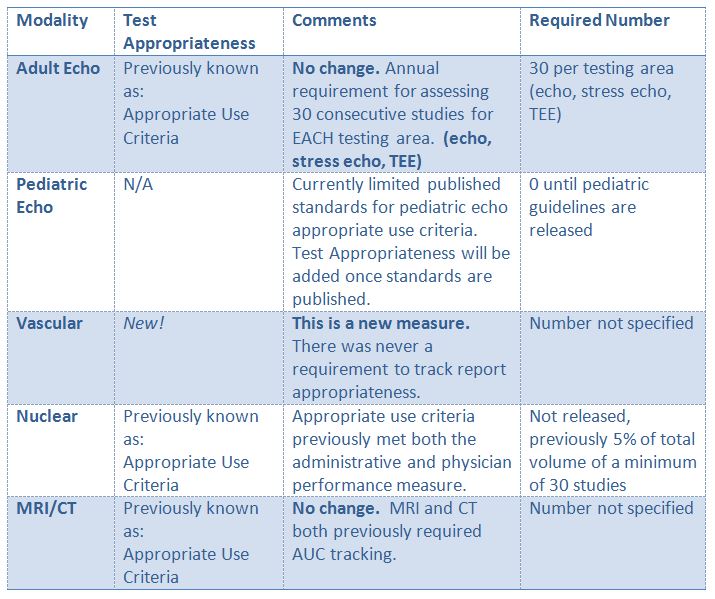
TECHNICAL QUALITY
The second across-the-board required QI measure is the Technical Quality Measure. Most divisions already had some sort of technical measure that was required but sometimes under a different name. There are now 3 standardized features of the new Technical Quality Measure with an additional safety measure as applicable. The technical quality measure includes review of:
- the clinical images for clarity of images and/or evaluation for suboptimal images or artifact
- completeness of the study
- adherence to the facility imaging acquisition protocols
- patient and facility safety for MRI and CT (Nuclear not released)
The previous Technical Quality assessment for MRI/CT has been amended to follow the new standardized requirements and in addition a new safety measure was added. Adult and Pediatric echo will continue to complete a sonographer technique assessment while the Vascular Division, once again, will have a brand new measure to add to their QI program. All modalities require the Technical Quality Findings to be discussed at Quality Improvement Meetings.
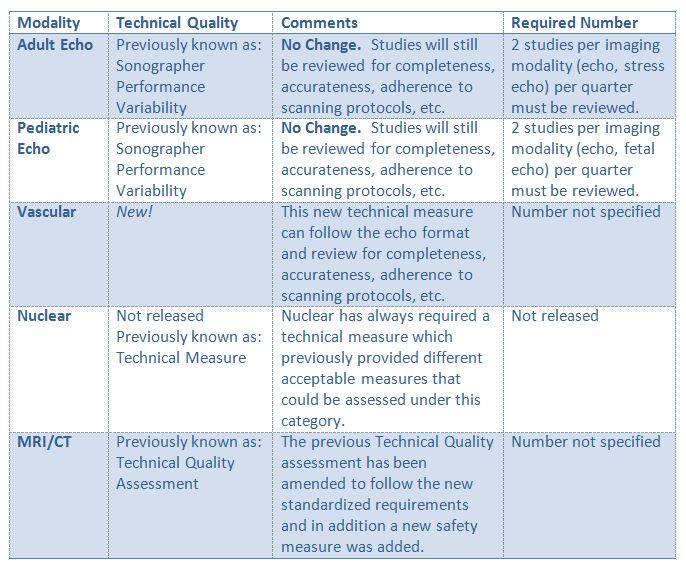
INTERPRETIVE QUALITY
The third across-the-board required QI measure is the Interpretive Quality Measure. All modalities must now evaluate the quality and accuracy of the interpretation based on the acquired images. Again, this was already part of the QI program for most of the imaging modalities under other names. For echo there was no change at all as the current physician peer review/variability program meets the Interpretive quality requirements. Other modalities (nuclear, CT and MRI) had previous QI measures that included some aspect of interpretive quality assessment as an option under broader categories. The biggest change was once again seen within the Vascular Division as yet another new measure was added. Don’t feel bad vascular friends, Vascular may have had the most measures added to their program but they also received the greatest reduction in regards to one of the biggest challenges vascular labs face. No spoiler alerts… we will cover that soon!
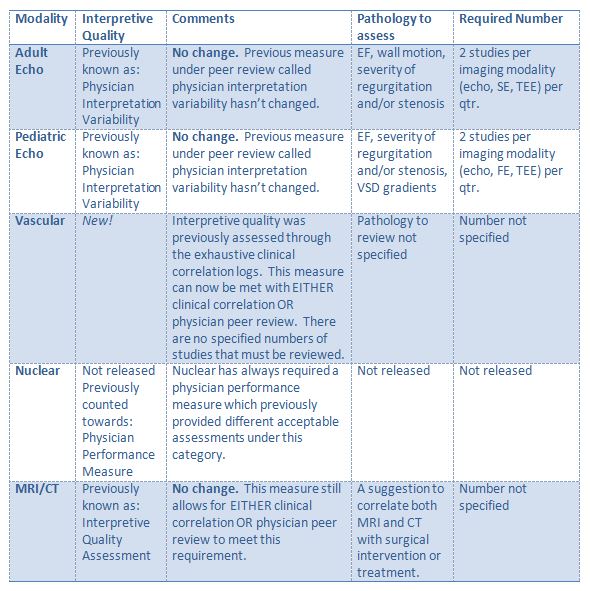
REPORT COMPLETENESS
The final standardized QI Measure for all imaging modalities to follow is Report Completeness. This measure requires evaluating final reports for completeness and timeliness. This is not new to echocardiography and the set requirement of 10 studies per quarter still stands. This is a new required measure for all other imaging modalities and the number of reports to assess was not specified.
Interestingly, complete reporting has always been a requirement to achieve accreditation and any facility submitting incomplete reports would be placed in a delayed status and asked to submit complete reports to rectify the delayed status. As accreditation consultants we have always assessed the completeness of reports as a tool to prepare our clients for successful accreditation. We like this new measure as we feel it will help labs be better prepared to identify reporting deficiencies and template issues sooner, allowing for the easier submission of compliant reports.
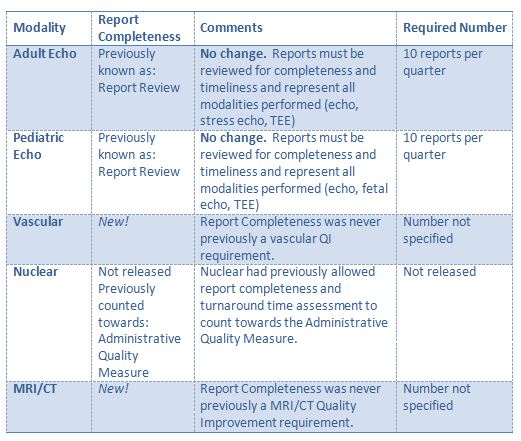
WILD CARD!
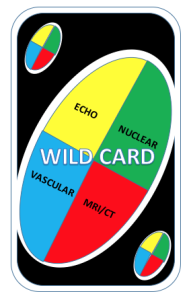
We now have reviewed the 4 mandated across-the-board Quality Improvement Measures for all imaging modalities which included test appropriateness, technical quality, interpretive quality and report completeness. As we mentioned earlier though, IAC is allowing each imaging modality a wild card to include one additional measure per modality.
MRI chose to not add any additional requirements. Nuclear has not released their updated program. CT added a new Radiation Safety Measure. Echo, both adult and pediatric, decided to keep their clinical correlation requirements as their wild card so once again the echo QI measures did not change. In fact, although keeping the clinical correlation measure the Echo Division reduced both the total number of required studies and the frequency of assessment. Clinical correlation is no longer a quarterly measure but now an annual measure with the total number of required cases reduced to a minimum of 4 cases annually with at least 2 cases per testing area.
Drum roll please as we announce the vascular wild card………
This just leaves vascular. The one division that saw the most changes with the entire quality improvement program redesigned. So is there good news somewhere here within the wild card section? Oh yes! Vascular chose a wild card they called Case Review which replaces the functionality of their clinical correlation but … this is where we play the drum roll… with a massive reduction in the hard to get, pull your hair out, “are you kidding me?” past requirements of 30 clinical correlations PER testing area. Are you sitting down? Vascular reduced their required number of clinical correlations from thirty (30) cases PER testing area down to just TWO (2)! That’s not a typo, they really reduced the clinical correlation log down to just TWO per year per testing area!!
So for all you vascular folks, before you fret about the complete redesign of the entire vascular quality improvement program rejoice in the ease of the clinical correlation that you will now breeze through!
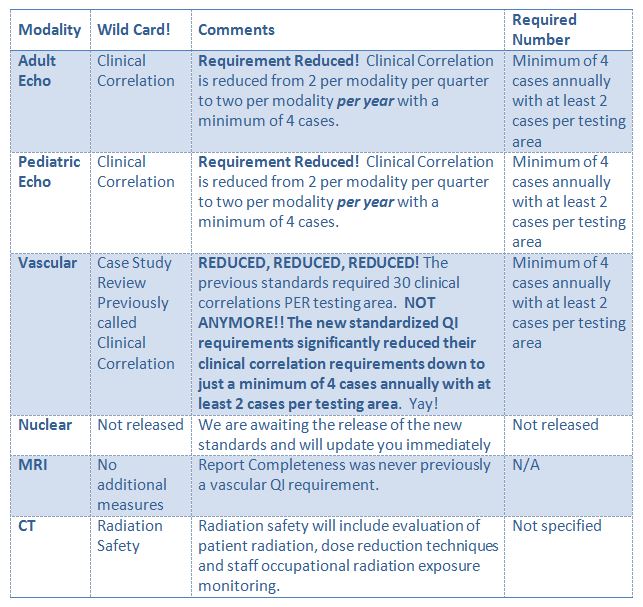
QUALITY IMPROVEMENT DOCUMENTATION
There’s a common phrase used in regards to compliance and that’s “If you didn’t document it, it didn’t happen!” Remember to document all your QI findings. This documentation needs to be readily available to all staff and needs to be presented at one of your Quality Improvement Meetings. You can also keep your measures in a QI Binder, post them in your department break room, or post it on your hospital’s internal intranet that allows access to all staff members.
QUALITY IMPROVEMENT MEETINGS
Following the theme of easing up on the burden of Quality Improvement Measures IAC standardized the number of required QI Meetings to only 2 meetings per year. For echo and nuclear this was a welcomed reduction from the previously mandated 4 meetings annually. Here is a summary of the new, easier QI requirements:
- 2 meetings per year
- All staff must attend at least one
- The findings from the QI Measures must be presented at least one meeting
- The preference is for physical attendance but remote attendance allowed (via phone or internet)
- In worst case scenario, when attendance is near impossible, the meeting minutes may be reviewed and signed off
Remember, there are still plenty of Quarterly QI measures across the board so if you have a system in place to facilitate the completion of quarterly measures at your QI Meetings, specifically physician peer review – don’t mess with a good thing! The 2 meetings per year are assuming that all peer review is still completed quarterly. For facilities that don’t want to start assigning homework to the physicians, quarterly working meetings may still be the best option!
ACCREDITATION HACKS
Where are all the time saving hacks? Remember, step one in greatly reducing a task is to have a clear understanding of what is required. This week we explained the new standardized Quality Improvement Program.
- Test Appropriateness
- Technical Quality
- Interpretive Quality
- Report Completeness
- Wild Card
Now you know the 4 required measures and the wildcard we will reveal time saving techniques and tricks to completing each measure in our upcoming blogs.
NEED HELP?
Remember the staff at the Intersocietal Accreditation Commission are the nicest, professional and helpful group of individuals you could ever want to work with! Don’t be shy about reaching out to them for assistance and checking out all their useful resources they provide on their website. They even provide sample documents for you to use in regards to both policies and QI forms.
Our Team at CardioServ takes great pride in helping our clients achieve the recognition of accreditation and maintaining their accreditation through an ongoing QI Program. Remember, if you are struggling with accreditation you can always reach out to us for help. Schedule a consultation to discuss your specific challenges, email us or call us. If you’re just too busy to handle your accreditation needs allow us to take care of everything for you from start to finish.
We look forward to sharing tips and techniques to ensure your success. Stay tuned for our future posts within this series that will address Accreditation Hacks to save you time while maintaining quality and accurateness.


